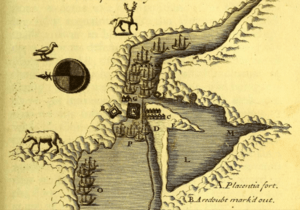Fort Saint Louis (Newfoundland) facts for kids
Fort Saint Louis was an important French fort built a long time ago in the 1600s. It was located on the island of Newfoundland when it was part of New France.
Contents
Why Was Fort Saint Louis Built?
The French started building Fort Saint Louis in 1690. This was part of a bigger plan to protect their land and trade.
A Key Trading Spot
Back in 1662, the French set up a special trading post. It was in a safe bay that looked out over Placentia Bay, Newfoundland. This bay was important because it separated the Avalon Peninsula from the rest of Newfoundland. It was also close to the Grand Banks of Newfoundland, which was a great place for fishing.
Protecting Plaisance
To keep this valuable area safe, the French built several forts around the bay. These included Fort Plaisance (built in 1662) and Fort Royal (built in 1687). Fort Saint Louis was built inside the harbor. Its main job was to protect the small port city of Plaisance from enemy attacks. It was made to make the older wooden fort in Placentia even stronger.
What Was Fort Saint Louis Like?
Fort Saint Louis was a very strong fort. It was built using stone, which made it much tougher than wood.
Size and Features
The fort's walls stretched for almost 250 meters. Inside, there were two strong towers called bastions. These towers helped defend the fort. The governor's headquarters and buildings for the soldiers were also inside. The walls of the fort were four meters high and two meters thick. This made them very hard to break through.
Fort's Defenses
Fort Saint Louis had nearly thirty cannons ready to fire. These cannons were very important for defending against any ships or armies that tried to attack.
What Happened to Fort Saint Louis?
Fort Saint Louis played a role in a big war.
The Battle of Placentia
The fort was attacked during a conflict known as King William's War. This attack happened during the Battle of Placentia (1692). The fort's strong defenses helped it survive this battle.
French Leave Newfoundland
In 1713, a peace agreement called the Treaty of Utrecht (1713) was signed. This treaty meant that the French had to give up their settlements in Newfoundland. Because of this, 'Plaisance' became 'Placentia'. The French people living there moved to a new place called Île Royale. There, they started building another famous fort, the Louisbourg.


